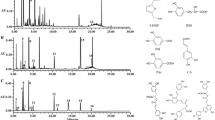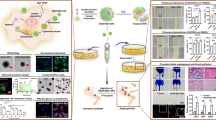Abstract
Objective
To investigate the effect and mechanism of Xuefu Zhuyu Capsule (血府逐瘀胶囊, XZC) on pro-angiogenesis in the hindlimb ischemic model rats.
Methods
A total of 100 Sprague Dawley rats were randomly divided into a model group, a regular-dose XZC group (0.48 g•kg-1•d-1) and a high-dose XZC group (0.96 g•kg-1•d-1) using random number table method. The model of hindlimb ischemic rats were made through femoral artery embolization with Bletilla microsphere agent. XZC were given on the first day after embolization surgery and lasted 5 days. Finally 72 models were obtained with 12 in each group for each time point. The lower ischemic limb was amputated on the third day after embolization surgery. Histopathological characters and the number of blood vessels of granulation tissues were observed at 36 and 48 h after amputation, respectively. The main genes were obtained from microarray analysis and were validated using real-time quantitative polymerase chain reaction.
Results
The vascular number of granulation tissues at both 36 and 48 h were characterized by new and fresh vessels. The number of angiogenesis in the high-dose XZC group at 36 and 48 h was greater compared with that in the regular-dose XZC and model groups (P<0.01), and high-dose XZC at 36 h increased more vessels than that at 48 h (P<0.01). Consequently, granulation tissues from the high-dose XZC group at 36 h were chosen for microarray analysis. In all, 2,085 differentially expressed genes (DEGs) were detected and 25 DEGs were determined to be directly related to angiogenesis. Four biological process terms were found including angiogenesis, regulation of angiogenesis, positive regulation of angiogenesis, and positive regulation of vascular endothelial growth factor receptor signaling pathway (P<0.05). Microarray analysis also showed 49 pathways including 11 pathways related to angiogenesis.
Conclusion
XZC promoted angiogenesis moderately and the mechanism involved multiple DEGs and multiple pathways.
Similar content being viewed by others
References
Su JT, Li G, Gao YL, Wang J, Du J, Wang P, et al. Mortality and years of life lost due to cardiovascular disease in Beijing, 2014. J Cardio Pulmon Dis 2016;35:87–90.
Carmeliet P, Jain RK. Molecular mechanisms and clinical applications of angiogenesis. Nature 2011;473:298–307.
Simons M. Angiogenesis: where do we stand now? Circulation 2005;111:1556–1566.
Gao D, Wu L, Jiao Y, Chen W, Chen Y, Kaptchuk TJ, et al. The effect of Xuefu Zhuyu Decoction on in vitro endothelial progenitor cell tube formation. Chin J Integr Med 2010;16:50–53.
Song J, Chen W, Wu L, Zheng L, Lin W, Gao D, et al. A microarray analysis of angiogenesis modulation effect of Xuefu Zhuyu Decoction on endothelial cells. Chin J Integr Med 2012;18:502–506.
Zhang J, Wang Y, Hu Y, Lin F, Gao D, Song J, et al. Effect of EphB4/EphrinB2 reverse signal on angiogenesis induced by Xuefu Zhuyu Capsule containing serum in human microvascular endothelial cell 1. Chin J Integr Med 2016;22:605–610.
Xin QQ, Yang BR, Zhou HF, Wang Y, Yi BW, Cong WH, et al. Paeoniflorin promotes angiogenesis in a vascular insufficiency model of zebrafish in vivo and in human umbilical vein endothelial cells in vitro. Chin J Integr Med 2018;24:494–501.
Wang Y, Guo G, Yang BR, Xin QQ, Liao QW, Lee SM, et al. Synergistic effects of Chuanxiong-Chishao herb-pair on promoting angiogenesis at network pharmacological and pharmacodynamic levels. Chin J Integr Med 2017;23:654–662.
Song J, Chen WY, Wu LY, Zheng LP, Lin W, Gao D, et al. A microarray analysis of angiogenesis modulation effect of Xuefu Zhuyu Decoction on endothelial cells. Chin J Integr Med 2012;18:502–506.
Grote K, Salguero G, Ballmaier M, Dangers M, Drexler H, Schieffer B. The angiogenic factor CCN1 promotes adhesion and migration of circulating CD34+ progenitor cells: potential role in angiogenesis and endothelial regeneration. Blood 2007;110:877–885.
Chen N, Chen CC, Lau LF. Adhesion of human skin fibroblasts to Cyr61 is mediated through integrin alpha 6beta 1 and cell surface heparan sulfate proteoglycans. J Biol Chem 2000;275:24953–24961.
Schober JM, Chen N, Grzeszkiewicz TM, Jovanovic I, Emeson EE, Ugarova TP, et al. Identification of integrin alpha(M)beta(2) as an adhesion receptor on peripheral blood monocytes for Cyr61 (CCN1) and connective tissue growth factor (CCN2): immediate-early gene products expressed in atherosclerotic lesions. Blood 2002;99:4457–4465.
Athanasopoulos AN, Schneider D, Keiper T, Alt V, Pendurthi UR, Liegibel UM, et al. Vascular endothelial growth factor (VEGF)-induced up-regulation of CCN1 in osteoblasts mediates proangiogenic activities in endothelial cells and promotes fracture healing. J Biol Chem 2007;282:26746–26753.
Bai T, Chen CC, Lau LF. Matricellular protein CCN1 activates a proinflammatory genetic program in murine macrophages. J Immunol 2010;184:3223–3232.
Mo FE, Muntean AG, Chen CC, Stolz DB, Watkins SC, Lau LF. CYR61 (CCN1) is essential for placental development and vascular integrity. Mol Cell Biol 2002;22:8709–8720.
Maity G, Mehta S, Haque I, Dhar K, Sarkar S, Banerjee SK, et al. Pancreatic tumor cell secreted CCN1/Cyr61 promotes endothelial cell migration and aberrant neovascularization. Sci Rep 2014;4:4995.
Fataccioli V, Abergel V, Wingertsmann L, Neuville P, Spitz E, Adnot S, et al. Stimulation of angiogenesis by Cyr61 gene: a new therapeutic candidate. Hum Gene Ther 2002;13:1461–1470.
Wong JH, Ye XJ, Ng TB. Cathelicidins: peptides with antimicrobial, immunomodulatory, anti-inflammatory, angiogenic, anticancer and procancer activities. Curr Protein Pept Sci 2013;14:504–514.
Salvado MD, Di Gennaro A, Lindbom L, Agerberth B, Haeggstrom JZ. Cathelicidin LL-37 induces angiogenesis via PGE2-EP3 signaling in endothelial cells, in vivo inhibition by aspirin. Arterioscler Thromb Vasc Biol 2013;33:1965–1972.
Author information
Authors and Affiliations
Contributions
Shi WL is responsible for the most work of the experiment, including model production, HE staining and analysis of results. Lu PF assisted in the production of animal models and HE staining. Gao D supervised the implementation of the whole experiment and assisted in the writing of this article. Song J supervised the implementation of the whole experiment. Chen KJ reviewed the entire work and article.
Corresponding author
Additional information
Conflict of Interest
The authors declare that there are no conflicts of interest regarding the publication of this paper.
Supported by the National Natural Science Foundation of China (No. 81072933, 81173431) and the Beijing Natural Science Foundation Program (No. 7122120)
Rights and permissions
About this article
Cite this article
Shi, Wl., Lu, Pf., Gao, D. et al. Effect of Xuefu Zhuyu Capsule (血府逐瘀胶囊) on Angiogenesis in Hindlimb Ischemic Rats. Chin. J. Integr. Med. 26, 39–45 (2020). https://doi.org/10.1007/s11655-019-3059-x
Accepted:
Published:
Issue Date:
DOI: https://doi.org/10.1007/s11655-019-3059-x




